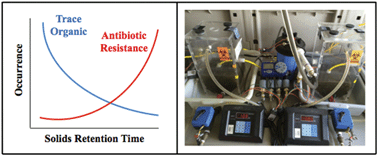当前位置:
X-MOL 学术
›
Environ. Sci.: Water Res. Technol.
›
论文详情
Our official English website, www.x-mol.net, welcomes your
feedback! (Note: you will need to create a separate account there.)
Solids retention time, influent antibiotic concentrations, and temperature as selective pressures for antibiotic resistance in activated sludge systems
Environmental Science: Water Research & Technology ( IF 3.5 ) Pub Date : 2017-06-29 00:00:00 , DOI: 10.1039/c7ew00171a Majid Neyestani 1, 2, 3, 4, 5 , Eric Dickenson 4, 6, 7, 8 , Jean McLain 4, 9, 10, 11 , Victoria Obergh 4, 10, 11, 12 , Oscar Quinones 4, 6, 7, 8 , Channah Rock 4, 10, 11, 12 , Daniel Gerrity 1, 2, 3, 4
Environmental Science: Water Research & Technology ( IF 3.5 ) Pub Date : 2017-06-29 00:00:00 , DOI: 10.1039/c7ew00171a Majid Neyestani 1, 2, 3, 4, 5 , Eric Dickenson 4, 6, 7, 8 , Jean McLain 4, 9, 10, 11 , Victoria Obergh 4, 10, 11, 12 , Oscar Quinones 4, 6, 7, 8 , Channah Rock 4, 10, 11, 12 , Daniel Gerrity 1, 2, 3, 4
Affiliation

|
This study evaluated the occurrence and potential proliferation of antibiotic resistance during biological wastewater treatment as a function of solids retention time (SRT), influent antibiotic concentrations, and temperature. Two phases of experiments were performed in laboratory-scale sequencing batch reactors (SBRs) fed with primary effluent from a full-scale wastewater treatment plant. Phase 1 evaluated SRTs of 2, 7, and 20 days with ambient antibiotic concentrations, and phase 2 evaluated a constant SRT of 7 days with influent antibiotic concentrations of 1×, 10×, and 100× relative to ambient levels. Ampicillin, sulfamethoxazole/trimethoprim, tetracycline, and vancomycin resistance were evaluated among Gram positive cocci (Staphylococcus and Streptococcus) using spread plate and minimum inhibitory concentration (MIC) assays. The laboratory-scale data demonstrated that biological treatment, in addition to longer SRTs, higher influent antibiotic concentrations, and higher temperatures, often resulted in greater relative prevalence of antibiotic resistance (up to 35% of the target population), and antibiotic resistant isolates were generally resistant to antibiotic concentrations 32 times higher than their baseline MICs. Some of these relationships were antibiotic-specific, with SRT having no significant impact on tetracycline resistance, influent antibiotic concentration having no significant impact on sulfamethoxazole/trimethoprim resistance, and temperature having no significant impact on vancomycin resistance.
中文翻译:

固体保留时间,进水抗生素浓度和温度作为活性污泥系统中抗生素耐药性的选择压力
这项研究评估了生物废水处理过程中抗生素抗药性的发生和潜在扩散与固体保留时间(SRT),进水抗生素浓度和温度之间的关系。在实验室规模的分批反应器(SBR)中进行了两个阶段的实验,这些反应器中装有来自大型废水处理厂的主要废水。第1阶段在环境抗生素浓度下评估了2、7和20天的SRT,第2阶段在流入抗生素浓度相对于环境水平下评估了7天的恒定SRT。在革兰氏阳性球菌(葡萄球菌和链球菌)中评估了氨苄西林,磺胺甲恶唑/甲氧苄啶,四环素和万古霉素的耐药性),使用扩散板和最小抑菌浓度(MIC)分析。实验室规模的数据表明,除了更长的SRT,更高的进水抗生素浓度和更高的温度外,生物处理通常还导致相对较高的抗生素耐药性流行率(高达目标人群的35%),并且对抗生素耐药的分离株通常对抗生素浓度的抵抗力比其基线MIC高32倍。这些关系中的一些是抗生素特异性的,SRT对四环素抗性没有显着影响,进水抗生素浓度对磺胺甲恶唑/甲氧苄啶抗性没有显着影响,温度对万古霉素抗性没有显着影响。
更新日期:2017-08-24
中文翻译:

固体保留时间,进水抗生素浓度和温度作为活性污泥系统中抗生素耐药性的选择压力
这项研究评估了生物废水处理过程中抗生素抗药性的发生和潜在扩散与固体保留时间(SRT),进水抗生素浓度和温度之间的关系。在实验室规模的分批反应器(SBR)中进行了两个阶段的实验,这些反应器中装有来自大型废水处理厂的主要废水。第1阶段在环境抗生素浓度下评估了2、7和20天的SRT,第2阶段在流入抗生素浓度相对于环境水平下评估了7天的恒定SRT。在革兰氏阳性球菌(葡萄球菌和链球菌)中评估了氨苄西林,磺胺甲恶唑/甲氧苄啶,四环素和万古霉素的耐药性),使用扩散板和最小抑菌浓度(MIC)分析。实验室规模的数据表明,除了更长的SRT,更高的进水抗生素浓度和更高的温度外,生物处理通常还导致相对较高的抗生素耐药性流行率(高达目标人群的35%),并且对抗生素耐药的分离株通常对抗生素浓度的抵抗力比其基线MIC高32倍。这些关系中的一些是抗生素特异性的,SRT对四环素抗性没有显着影响,进水抗生素浓度对磺胺甲恶唑/甲氧苄啶抗性没有显着影响,温度对万古霉素抗性没有显着影响。











































 京公网安备 11010802027423号
京公网安备 11010802027423号